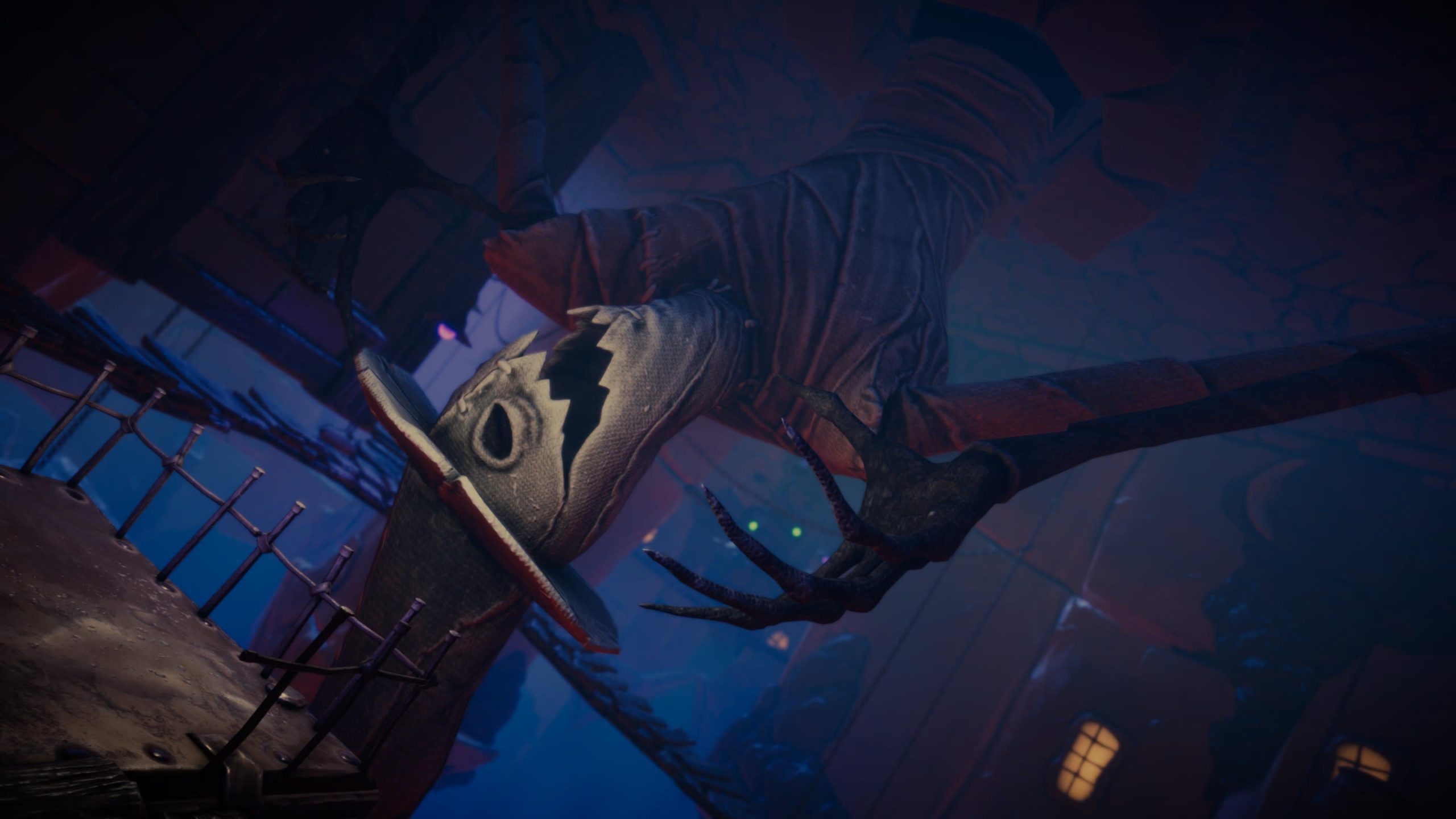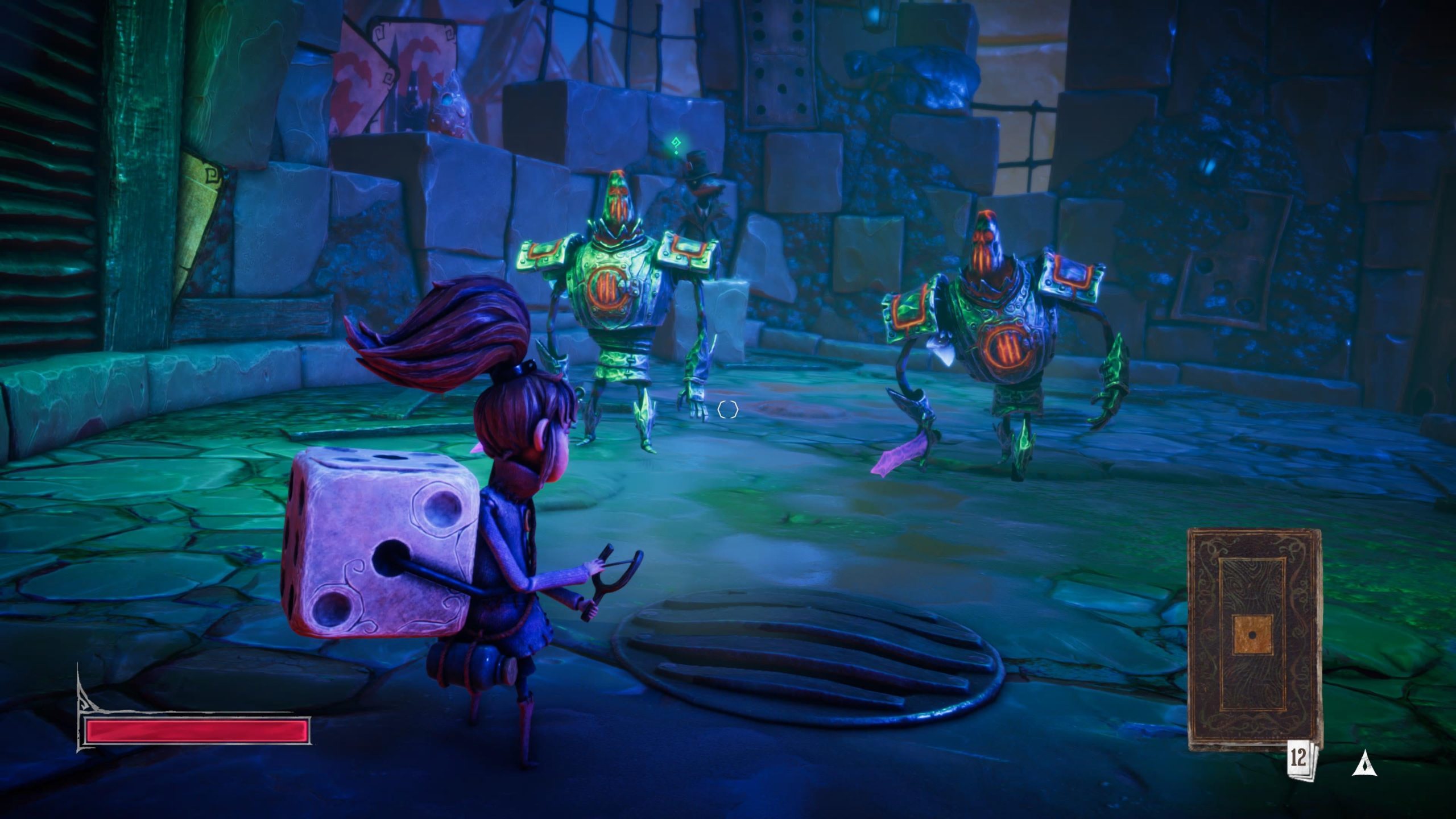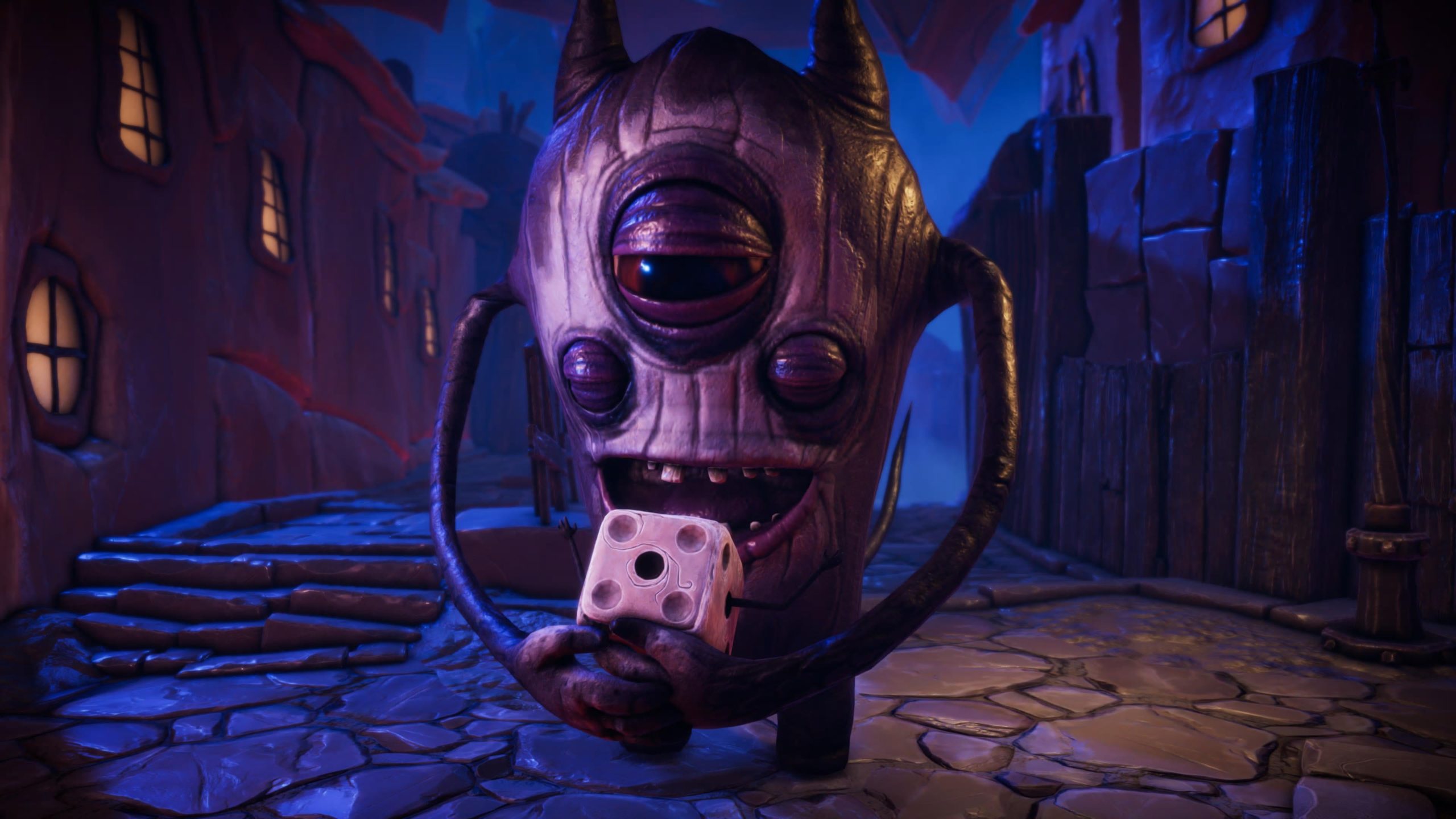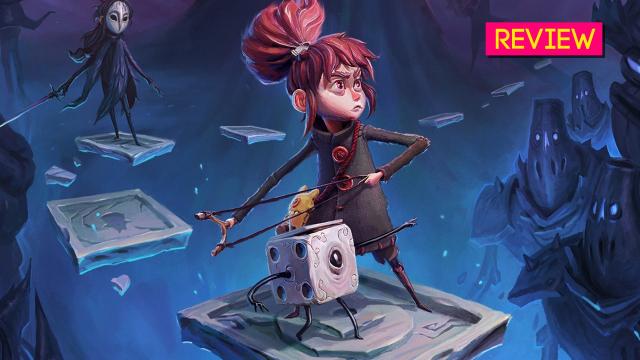I play a lot of games for this job. That’s not a brag, it’s just a fact. And while many of those games are good, most of them tend to blend together. But whenever something comes along that is not only great but also feels fresh and incredibly memorable, it reminds me of how awesome games can be. Lost in Random is one of these games. It combines a unique world with great writing, wonderfully quirky visuals, and a combat system that’s unlike anything I’ve played before.
Lost in Random is set in the world of…Random. (Hence the name of the game.) Here, life is determined by the roll of a magical die wielded by the incredibly tall and scary Queen. There are six lands in Random, one for each number found on your average six-sided die. At the age of 12, children roll the Queen’s evil die and the number they get determines where they will live for the rest of their lives. Lost in Random’s adventure begins in the land of Onecroft, which is the worst place to end up in all of Random. It’s just a giant junkyard where people scrounge every day, shipping off metal and other useful objects in boats to unseen parts of Random for reasons they are never told.
This is where young sisters Odd and Even live. They make the best of their miserable little town, often telling tales of the past. Back then, before the Queen, everyone had magical dice and the land prospered, as folks used their number cubes to make decisions and add some spice of randomness to their lives. But once the Queen took over, she started a war against all the dice in the land, destroying every last one so that only she had a powerful, magic die.
At the start of the game, the Queen and her cronies arrive at Onecroft and summon all the 12-year-olds in the land to roll her evil die. Even’s sister Odd rolls a six and is whisked away to places unknown, leaving poor Even alone and heartbroken. In the wake of Odd’s departure, Even is visited by a strange ghost and troubled by creepy, prophetic dreams, which convince her to sneak out of Onecroft, find out what happened to her sister, and hopefully save her. She quickly encounters a lonely magic die, a survivor of the Queen’s violent crusade, possibly the last of his kind. Alongside this new friend, named Dicey, Even sets off across the lands of Random to find her sister and stop the evil Queen who stole Odd away.
The world of Lost in Random is inspired by films like Tim Burton’s The Nightmare Before Christmas and Laika’s Coraline and ParaNorman. This means lots of twisty buildings and paths, oddly shaped townsfolk, and a general sense of eerie stuffed into every inch of Random. Like those films, everything in Lost in Random looks handmade too, as if this game were based on a stop-motion movie that never got released in our timeline. Exploring this world is a genuine treat, as each numbered region feels different. Onecroft is a bit of a trash heap, but Two-Town is a complex and claustrophobic urban world, with an upside-down city and evil mayor floating above it, complete with a second moon too. Another world feels like a hidden den of sin and magic, populated mostly by misfits from other parts of the kingdom.

I had a great time just poking my head into every nook and cranny of the various realms, looking for characters to talk to and side-quests to complete. Lost in Random isn’t a massive game — you can beat it in 12 hours or less — but what’s here is fantastic. One quest had me searching the world for ghost stories that I could bring back to a man obsessed with spooky things. Using the game’s dialogue options, I could even exaggerate the stories, making them scarier or sadder depending on how I felt. For some quests, you can talk your way out of or into a bad situation. The range of dialogue options and the ways in which they impact the game are yet another reason I had such a good time exploring and talking to everyone I met.
But Lost in Random is more than just a nice-looking game with some weird NPCs and silly side-quests. Throughout your adventure, Even and Dicey encounter royal robots who will, as you might expect, try to stop the duo from making it to Sixopolis, where the Queen rules over the kingdom. Luckily, Dicey is one badass number cube.
When combat starts, you first need to collect some energy by breaking crystals that spawn in the world and also on baddies. After getting some sweet energy, you’re dealt some cards. Once you have both cards and energy, a simple toss of Dicey freezes time, letting you freely move around, while planning what cards you’ll use. Each one provides you with various abilities, buffs, or items. Depending on what you roll, you’ll be able to play some or possibly all of the cards in your hand.

So you might roll a three, earning you three card tokens. With that, you can play the sword card which costs one token and gives you a magic blade with which you can hack up enemies. But you still have two more tokens to use, so you might also play a bomb card which costs two and lets you place explosives near any enemies. Maybe you get lucky and get a card that gives you a free token that costs nothing to use, letting you play something bigger like the hammer card which costs three, or multiple smaller cards like the King’s Hand, which only costs one and pushes enemies around, dealing damage. The moment you attack an enemy or set off a trap, like a bomb, time goes back to normal and you need to earn more energy to get dealt more cards. You eventually repeat the whole cycle over until your enemies are vanquished.
It’s exciting how fights in Lost in Random never play out the same way. I was always on my toes, with some encounters really pushing me to focus after a string of bad rolls. If Lady Luck ain’t on your side things can get tricky, but never impossible. I always felt there was a way to win, even if it involved some cheat cards.
This combat system also has an interesting loop to it. At the start of each fight, all you have is your weak slingshot, which can’t do damage to enemies and is only useful for setting off traps or breaking energy crystals. So every encounter starts with you having to be scrappy and careful. But as you get energy and start playing cards, the tables turn, and eventually Even becomes flush with abilities and weapons, not to mention cards. This gives every fight a nice beginning, middle, and end. It also means that you don’t become overly powerful and bored of combat long before reaching the end of the game.
[review heading=”Lost in Random” image=”https://www.gizmodo.com.au/wp-content/uploads/sites/3/2021/09/24/a7de149d469ec33ea01aee390f51cf81.jpg” label1=”BACK OF THE BOX QUOTE” description1=”‘Random rules! And so does Lost in Random.’” label2=” TYPE OF GAME” description2=”Action-adventure + tabletop gaming with a bit of Tim Burton-esque worldbuilding” label3=”LIKED” description3=”Wonderful art and style, innovative combat, great writing, perfect length” label4=”DISLIKED” description4=”Small deck size, a bit of a slow start” label5=”DEVELOPER” description5=”Zoink Games” label6=”PLATFORMS” description6=”PS5 (played), PS4, Xbox One, Xbox Series X/S, Switch, PC” label7=”RELEASE DATE” description7=”September 10, 2021″ label8=”PLAYED” description8=”Just over 12 hours. Collected all the storybook pages, completed all optional puzzles and most side quests, and finished the main storyline. ” ]
As you progress through the world, you earn new cards, some of which are more powerful, from completing quests or by buying them from shops. You then use all of the cards you have to build a 15-card deck that suits your playstyle. If you prefer running around dodging attacks and dealing direct damage, you probably want a bunch of weapon cards that give you swords, bows, and spears. You can also rely on turrets, traps, or creatures to do your bidding for you instead. Or you can be like me and toss in a bunch of cheat cards that let you play cards without needing as many tokens, or which just give you extra tokens for nothing. The number of options you have when building your deck is impressive, though I do wish the game let you build bigger decks, as near the end I had such a large collection of cool cards, and not enough room to bring all of my favourites into battle.
Occasionally you encounter board game arenas. These use the same combat mechanics as the rest of the game, but also feature a game piece that Even needs to move around via dice rolls. Here, the robots will keep spawning, forcing Even to focus more on moving the game piece as quickly as possible, which shifts the dynamics of combat by changing up which cards in your arsenal might be the most valuable. These areas are a nice change of pace and, outside the game’s handful of bosses, include some of its biggest and hardest fights.
At its core, Lost in Random is a story about free will, destiny, and moving on. The Queen, the game’s big baddie, is a terrifying presence, but as you learn more about her, you realise that she is more obsessed with preventing the fate of someone else than destroying the world you and your sister call home. It just so happens that she can only get what she wants via destruction and pain. The game also digs into the idea of whether random is fair, and if we are even living in a world of random chaos or if destiny has a plan for all of us. Is a dice roll random? Or does it reveal fate’s bigger plans?

Don’t worry, Lost in Random doesn’t pull a Biomutant and spend far too many hours pontificating about these topics. But when it does decide to devote time to its themes, it often feels effortless. It’s the kind of writing that makes me grumble, not because I hate it, but because I’m jealous over how perfectly it all comes together. The game even features an interesting, not-annoying narrator and it somehow fits that into the overall story and its themes of fate and destiny. Impressive stuff. Annoyingly impressive, honestly.
When I finished Lost in Random, I wanted to talk about it. I wanted to not just praise it, but really dig into the world and its combat system. It’s that kind of game that makes you wish you had a few people around you who also played it and who want to spend a few hours just going on and on about it. Sure, I wish there were bigger decks in the game, but that’s less a complaint and more an admittance that I just wanted more of Lost in Random.
And here, now, as I finish writing this review, I’m still unable to shake that feeling. This is one of my favourite games of 2021, and a treat for those looking for something new.

Leave a Reply